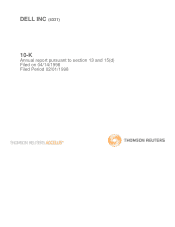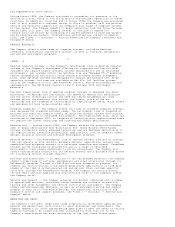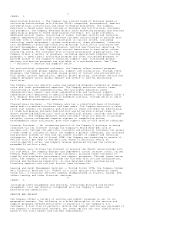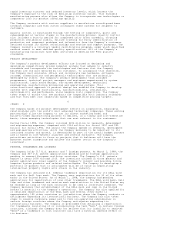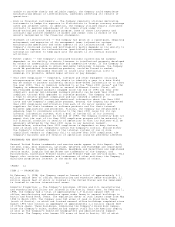Dell 1997 Annual Report Download - page 7
Download and view the complete annual report
Please find page 7 of the 1997 Dell annual report below. You can navigate through the pages in the report by either clicking on the pages listed below, or by using the keyword search tool below to find specific information within the annual report.rapid inventory turnover and reduced inventory levels, which lessens the
Company's exposure to the risk of declining inventory values. This flexible
manufacturing process also allows the Company to incorporate new technologies or
components into its product offerings quickly.
The Company contracts with various suppliers to manufacture unconfigured base
notebook computers and then custom configures these systems for shipment to
customers.
Quality control is maintained through the testing of components, parts and
subassemblies at various stages in the manufacturing process. Quality control
also includes a burn-in period for completed units after assembly, on-going
production reliability audits, failure tracking for early identification of
production and component problems and information from the Company's customers
obtained through its direct relationships and service and support programs. The
Company conducts a voluntary vendor certification program, under which qualified
vendors commit to meet defined quality specifications. All of the Company's
manufacturing facilities have been certified as meeting ISO 9002 quality
standards.
PRODUCT DEVELOPMENT
The Company's product development efforts are focused on designing and
developing competitively priced computer systems that adhere to industry
standards and incorporate the technologies and features that the Company
believes are the most desired by its customers. To accomplish this objective,
the Company must evaluate, obtain and incorporate new hardware, software,
storage, communications and peripherals technologies that are primarily
developed by others. The Company's product development team includes
programmers, technical project managers and engineers experienced in system
architecture, logic board design, sub-system development, mechanical
engineering, manufacturing processing and operating systems. This
cross-functional approach to product design has enabled the Company to develop
systems with improved functionality, manufacturability, reliability,
serviceability and performance, while keeping costs competitive. The Company
takes steps to ensure that new products are compatible with industry standards
and that they meet cost objectives based on competitive pricing targets.
6
<PAGE> 8
The Company bases its product development efforts on cooperative, meaningful
relationships with the world's most advanced technology companies. These working
partnerships allow the Company to use its direct marketing model and
build-to-order manufacturing process to deliver, on a timely and cost-effective
basis, those emerging technologies that are most relevant to its customers.
During fiscal 1998, the Company incurred $204 million in research, development
and engineering expenses, compared with $126 million for fiscal 1997 and $95
million for fiscal 1996. The amount the Company spends on research, development
and engineering activities, which the Company believes to be important to its
continued success and growth, is determined as part of the annual budget process
and is based on cost-benefit analyses and revenue forecasts. The Company
prioritizes activities to focus on projects that it believes will have the
greatest market acceptance and achieve the highest return on the Company's
investment.
PATENTS, TRADEMARKS AND LICENSES
The Company holds 317 U.S. patents and 7 foreign patents. At March 1, 1998, the
Company had 307 U.S. patent applications pending and 42 foreign applications
pending in several European and Asian countries. The Company's U.S. patents
expire in years 2005 through 2015. The inventions claimed in those patents and
patent applications cover aspects of the Company's current and possible future
computer system products and related technologies. The Company is developing a
portfolio of patents that it anticipates will be of value in negotiating
intellectual property rights with others in the industry.
The Company has obtained U.S. federal trademark registration for its DELL word
mark and its Dell logo mark. The Company owns registrations for 22 of its other
marks in the United States. As of March 1, 1998, the Company had pending
applications for registration of nine other trademarks. The DELL word mark, Dell
logo and other trademark and service mark registrations in the United States may
be renewed as long as the mark continues to be used in interstate commerce. The
Company believes that establishment of the DELL mark and logo in the United
States is material to the Company's operations. The Company has also applied for
or obtained registration of the DELL mark and several other marks in
approximately 190 other countries or jurisdictions where the Company conducts or
anticipates expanding its international business. The Company has also taken
steps to reserve corporate names and to form non-operating subsidiaries in
certain foreign countries where the Company anticipates expanding its
international business. The Company is precluded from obtaining a registration
for trademarks consisting of or incorporating the term "Dell" in certain foreign
countries, although the Company does not believe that its inability to register
"Dell" as a trademark in such countries will have a material adverse effect on
its business.

